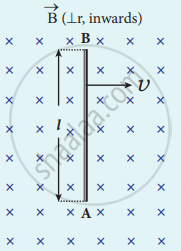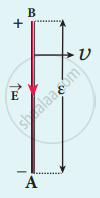Advertisements
Advertisements
प्रश्न
Obtain an expression for motional emf from Lorentz force.
उत्तर
Consider a straight conducting rod AB of length l in a uniform magnetic field `vec"B"` which is directed perpendicularly into the plane of the paper. The length of the rod is normal to the magnetic field. Let the rod move with a constant velocity `vec"v"` towards right side.
When the rod moves, the free electrons present in it also move with same velocity `vec"v"` in `vec"B"`. As a result, the Lorentz force acts on free electrons in the direction from B to A and is given by the relation
`vec"F"_"B" = - "e"(vec"v" xx vec"B")` ....(1)
The action of this Lorentz force is to accumulate the free electrons at the end A. This accumulation of free electrons produces a potential difference across the rod which in turn establishes an electric field E directed along BA. Due to the electric field E, the coulomb force starts acting on the free electrons along AB and is given by
`vec"F"_"E" = - "e"vec"E"` ....(2)
The magnitude of the electric field `vec"E"` keeps on increasing as long as the accumulation of electrons at the end A continues. The force `vec"F"_"E"` also increases until equilibrium is reached. At equilibrium, the magnetic Lorentz force `vec"F"_"B"` and the coulomb force `vec"F"_"E"` balance each other and no further accumulation of free electrons at the end A takes place, i.e.,
`|vec"F"_"B"| = |vec"F"_"E"|`
`|-"e" (vec"v" xx vec"B")| = |-"e" vec"E"|`
vB sin 90° = E
vB = E ……. (3)
The potential difference between two ends of the rod is
(a) 
(b)
Motional emf from Lorentz force
V = El
V = vBl
Thus the Lorentz force on the free electrons is responsible to maintain this potential difference and hence produces an emf.
ε = Blv ….. (4)
As this emf is produced due to the movement of the rod, it is often called as motional emf.
APPEARS IN
संबंधित प्रश्न
State the factors on which the strength of an electromagnet depends. How does it depend on these factors?
The direction of current in the coil at one end of an electromagnet is clockwise. This end of the electromagnet will be:
(a) north pole
(b) east pole
(c) south pole
(d) west pole
Describe one experiment to demonstrate the phenomenon of electromagnetic induction.
Calculate the dimensions of (a) \[\int \overrightarrow{E} . d \overrightarrow{l,}\] (b) vBl and (c) \[\frac{d \Phi_B}{dt}.\] The symbols have their usual meaning.
Draw and label the diagram of a simple D.C. motor.
(a) Explain the rotation of the coil, giving a reason for your answer.
(b) How can you reverse the direction of rotation of the armature?
(c) How can you increase the speed of rotation of the motor?
Fill in the blanks by writing (i) Only soft iron, (ii) Only steel, (iii) Both soft-iron and steel for the material of core and/or magnet.
D.C. motor ______.
State Fleming’s Right Hand Rule.
A cylindrical bar magnet (A) and similar unmagnetized cylindrical iron bar (B) are dropped through metallic pipe. The time taken to come down by ____________.
What should be the core of an electromagnet?
